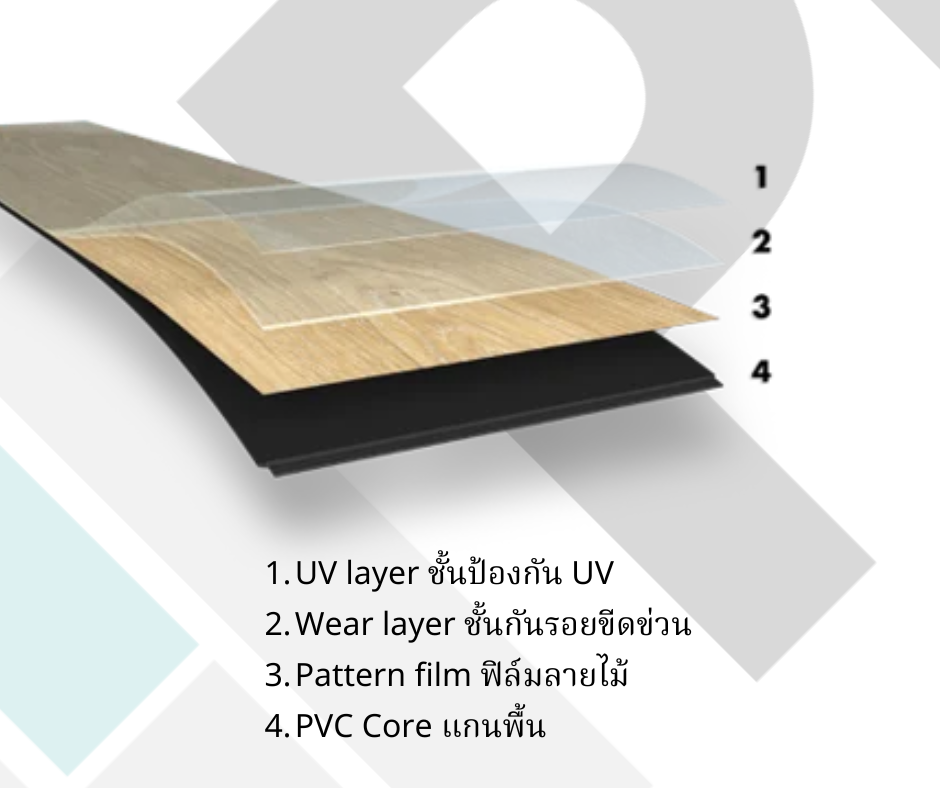Pros and Cons of Vinyl Flooring and Laminate Flooring: Know Them to Choose the Right Material for Your Needs
- seo5491
- Dec 22, 2023
- 4 min read
Updated: Mar 21
Nowadays, there are various types of flooring materials available, and people typically choose based on their intended use, followed by aesthetics and personal preferences. In this article, we will discuss vinyl flooring and laminate flooring, two popular options, especially for modern homes with minimalist, cozy, Muji-style, or Japanese-inspired designs. These materials add a soft, contemporary, and livable charm to any space.

Properties of Vinyl Flooring
Vinyl flooring is made from polymers (PVC) mixed with plasticizers, resulting in a tough yet bendable structure with anti-slip texture helps reduce the risk of slips and falls. It offers high flexibility, excellent impact resistance, and is 100% waterproof, moisture-resistant, and impervious to insects and termites. It features a wood-patterned film layer for aesthetic appeal, topped with a scratch-resistant coating. Additionally, it’s easy to clean, simple to install, and boasts a lifespan of up to 15 years. Today, the price of vinyl flooring is much more affordable compared to when it was first introduced, making it ideal for homes, shops, or hotels that prioritize beauty and functionality.
Advantages of Vinyl Flooring
Durable and non-swelling when exposed to water
Resistant to insects and termites
Produces minimal dust during installation
Easy to install without removing the existing floor, thanks to the Click-Lock system, which connects planks efficiently and saves time
Long lifespan of up to 15 years
Safe for users, reducing the risk of slipping accidents
Budget-friendly, perfect for those with limited funds
Disadvantages of Vinyl Flooring
Prone to scratches, not ideal for dragging heavy objects across the surface
Prolonged water submersion (e.g., flooding) may cause moisture-related damage
Not resistant to harsh chemicals, acids, or alkalis

Properties of Laminate Flooring
Laminate flooring is a synthetic material combining real wood with laminated paper. Its core is made from compressed wood powder mixed with resin and wax, then coated with a laminate layer, melamine, and resin to create various patterns. This results in laminate flooring offering a wide range of designs. Though not 100% natural, it has notable qualities: it mimics the look and texture of real wood—either smooth or embossed to replicate natural wood grains (Embossed in Register)—and provides moderate water resistance. It doesn’t conduct heat, feels comfortable underfoot, and its laminated surface effectively resists scratches. It also withstands pressure well, has a smooth surface that’s easy to clean, and is suitable for residential use in homes, condos, or dormitories.
Advantages of Laminate Flooring
Offers beauty with patterns and textures closely resembling real wood
Meets diverse preferences with a wide variety of colors and designs
Highly resistant to pressure and scratches
Easy to install with the Click-Lock system for seamless plank connection
Surface resists chemical stains well and is easy to wipe clean
Disadvantages of Laminate Flooring
Not fully water-resistant; prolonged exposure to water can cause swelling
Contains wood components, making it susceptible to insect damage
Installation may generate dust from cutting wood planks
Comparing Vinyl Flooring and Laminate Flooring
Moisture Resistance
Vinyl flooring outperforms in moisture and water resistance due to its PVC composition, which doesn’t absorb water. In contrast, laminate flooring is more prone to swelling or warping since it contains wood-based materials, offering less protection against moisture.
Pressure Resistance
Laminate flooring excels in withstanding pressure due to its thicker, denser structure compared to vinyl flooring.
Scratch Resistance
Laminate flooring is better at resisting scratches, thanks to its aluminum oxide coating, which is tougher than the polyurethane coating used in vinyl flooring.
Installation
Both vinyl flooring and laminate flooring are easy to install using the Click-Lock system, where planks interlock without glue. This DIY-friendly method saves time and reduces costs.
Texture
Vinyl flooring has a slightly sticky, grippy texture due to its polymer makeup, with wood-like patterns and varying texture options. Laminate flooring, made partly from real wood, feels smoother and more slippery but closely mimics natural wood texture.
Maintenance
Both vinyl flooring and laminate flooring are easy to clean with a damp mop. Avoid overly wet mopping, as excess water can seep into the surface and cause swelling. Regular floor cleaners are safe to use, but avoid stiff-bristled brushes to prevent scratches.
Choosing Between Vinyl Flooring and Laminate Flooring
Beyond matching your home’s concept and personal taste, opt for high-quality materials from reputable suppliers with proven expertise. This ensures durability, suitability for your space, and cost savings by minimizing installation damage.
Pergo Thailand Co., Ltd. is a leading distributor of laminate flooring, engineered wood, SPC flooring, and vinyl flooring in Thailand. Offering skirtings, trims, and finishing accessories. Our high-quality products suit both homes and offices. With over 20 years of experience, expert installation teams, and excellent after-sales service, Pergo (Thailand) is trusted by homeowners, contractors, designers, and top real estate developers nationwide. Our products are carefully selected for Thailand’s climate, delivering beauty, durability, and safety at a fair price.
Contact Pergo (Thailand) for Vinyl Flooring and Laminate Flooring
Tel: 064 525 6144
Line ID: evepergo
Email: nattinee@pergothailand.com
Facebook: https://www.facebook.com/pergofloor.th

Comments